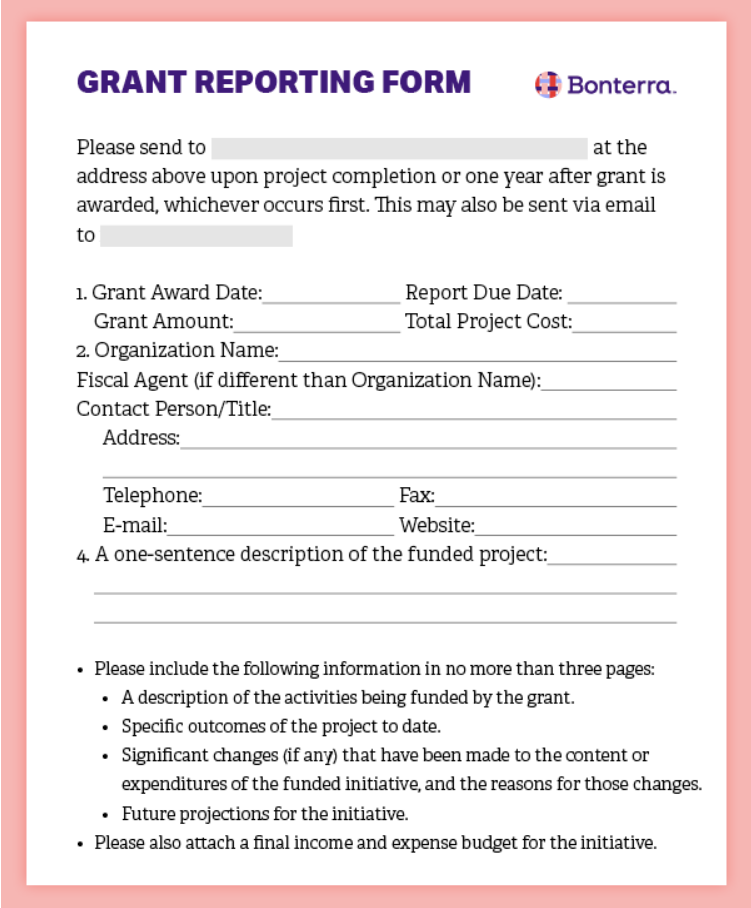Grants are an essential source of funding for many nonprofit organizations. Once you find a grant that’s the right fit for your organization and write a successful proposal, you’ll probably be excited to get started on the project your grant is funding. However, it’s never too early to start thinking about how to write a grant report that will secure a lasting relationship with the funder.
The more you prepare in advance, the more likely it is that you’ll be able to complete an effective grant report that fulfills the funder’s requirements. More than that, a quality grant report is a chance to showcase your organization’s professionalism and strengths, which often makes funders more willing to provide support in the future. In this guide, we’ll look at the five key elements of how to write a grant report:
 Let’s review each key element of a grant report in more detail.
Let’s review each key element of a grant report in more detail.
- Financial statements.
- Project activities.
- Results and impact.
- Lessons learned.
- Future plans and sustainability.
 Let’s review each key element of a grant report in more detail.
Let’s review each key element of a grant report in more detail.
1. Financial statements
Grant management always starts and ends with financial responsibility. So, the first element that most funders want to see in a grant report is financial information. As you use grant funding, make sure to keep a detailed account of your expenditures. Grant funding typically has restrictions placed on it by funders, so pay special attention to restricted fund accounting practices and make sure you can explain your accounting systems if asked. You might also need to include financial reports on your overall organization to demonstrate compliance with legal and grant-specific requirements. If you show in your financial statements that you’re using the funding to advance your purpose as agreed upon, you’ll prove to the funder that awarding funding to your organization was an investment well made.2. Project activities
Next, you’ll contextualize the financial statements in your grant report by showing why individual expenditures are necessary and valuable. Start with a brief narrative outlining the types of activities being funded by the grant. Then, show how those activities fit into your larger program objectives. Your grant application can serve as a reference for this section—just pay attention to any details that may have changed since you submitted your proposal. If you worked in collaboration with other organizations or leveraged volunteer resources, let the grantmaker know to show them you’re making the most of your grant-funded efforts.3. Results and impact
Information about your finances and activities is important to funders, and those two aspects of your report also contextualize the third key element: results and impact. Lasting relationships with funders are, in part, built on outcomes—if you report a positive impact, a funder will be more likely to support your organization again in the future. To demonstrate your impact in your grant report, include both quantitative and qualitative data. With the right grant management software, incorporating quantitative data is simple. Highlight key metrics that show the results of your initiative, then explain how grant funding contributed to those outcomes. Qualitative data, especially impact stories, can supplement quantitative data to add depth and meaning to your report. Although your primary goal is to provide the funder with information about how funds were used, demonstrating that your organization is professional and outcomes-oriented will show grantors that the funding they provided made a difference.4. Lessons learned
Naturally, you’ll want to emphasize your successes in your grant report. However, it’s also important to discuss your outcomes realistically and identify opportunities for growth. Most funders know that the only way to maximize a grant’s impact is to test assumptions and see what works. Even if the grant report instructions provided by the funder don’t explicitly ask for lessons learned, you’ll likely want to include them in your narrative. The goal of sharing lessons learned is to support the future success of your organization and other grant recipients. Explain what you assumed or hoped you would accomplish, what actually happened, and why (or your best understanding of why) the result was different. Then, frame the lessons you learned as actionable takeaways for the future. Funders tend to respect and appreciate organizations that discuss their experiences honestly and commit to acting on lessons learned. Plus, the process of working through challenges and identifying growth opportunities helps build stronger initiatives at your organization.5. Future plans and sustainability
Lastly, grant reporting should include projections and plans about the initiative’s next phase or your organization’s direction. While some grants are awarded with the expectation of one-time use, many funders see grants as an investment to create sustainable change. As you write your grant report, you can demonstrate sustainability in several ways, including:- Planning the next steps for the project or program.
- Discussing ways to continue funding the initiative.
- Setting specific future goals.
Leveraging effective grant reporting
Effective grant reporting requires a team effort. Make sure to communicate clearly what tasks each staff member is assigned to complete, and give everyone plenty of time to collect the necessary information. Also, confer with your team when the report is finished to refine metrics and allow everyone to share their unique perspectives. Now that you know how to write a quality grant report, you’ll be on your way to making a positive impression on funders and building relationships that you can leverage for future support.
Ready to Get Started?




